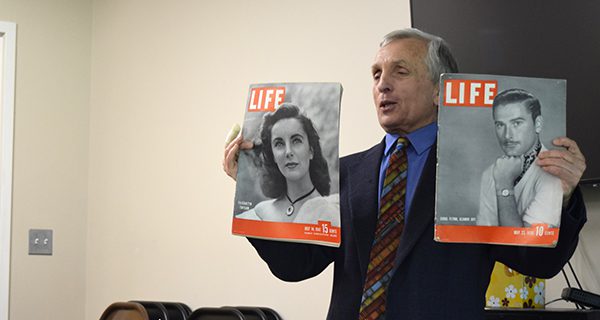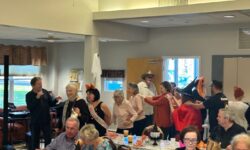[ccfic caption-text format="plaintext"]
By Christina Perrone
Hometown Weekly Intern
One man’s junk is another man’s treasure. This is especially true in the rare books business. On Tuesday, June 6, the Westwood Council of Aging invited Kenneth Gloss, owner of the Brattle Book Shop in Boston, to give a talk about his passion of rare books. The room was packed with people, many with vintage books for appraisal.
Gloss is well known for his role on the PBS television show, Antiques Roadshow, in which he, along with a number of expert collectors, tour the country, unearthing fascinating stories behind antiques. He is also famous for his internationally known store, The Brattle Book Shop in Boston’s Downtown Crossing. Founded in 1825, the store has been in his family since 1949.
“I guess the first thing that comes up when you talk about old books is what is an old book?” began Gloss. The first book ever printed was the Gutenberg Bible in 1456. A single page from a Gutenberg Bible can garner over $100,000. Half of the Gutenberg Bible sold recently for $5.5 million dollars. According to Gloss, any book printed in the 1400’s is valuable, no matter what. It gets a little more complicated from the 1500’s onward.
“You can have a book printed in the 1500’s that was a relatively dull and uninteresting book then, and it’s still a relatively dull and uninteresting book now and no one cares or will pay very much for it,” Gloss said.
On the other hand, some recent books sell for thousands. According to Gloss, “The first edition of the first ‘Harry Potter’ book in London could sell for $30,000 to $40,000. So, it’s all what people are looking for.”
The main aspect that determines a book’s value is its historical significance. To Gloss, “A book has to be historical: scientifically or literarily, or for some other reason important so that there are a group of collectors out there who want it. And usually when you think of first editions, you think of literature — Dickens, Twain, Faulkner, Fitzgerald, Hemingway, and so on. And even within that, there are a lot of things that will make a big difference in the price, the condition being one of the most important. The paper dust jacket on a 20th century book will make all the difference in the world.”
“A lot of the fun of collecting, is learning about something, is studying it, is appreciating it. It’s really good knowledge that makes something interesting, and thus valuable,” said Gloss, “Someone might look at something and say, ‘Look it’s a scrap of paper.’ Someone else might say, ‘Look, that’s a broadside that lead to the Boston Tea Party, that lead to the American Revolution, that lead to our country’s independence.’ So, it’s really that knowledge and understanding that makes things valuable.”
“One of the most interesting parts about the business for me is going out to houses and estates,” said Gloss, “That’s how we get most of the books.” On one house call, he met a lady in Sharon who had been married to the prince of Ukraine, the cousin of Nicholas II of Russia – the last tsar of Russia. Her husband had escaped just before the revolution. She went on to tell Gloss about how T.E. Shaw used to stay at her house and how she didn’t think his death was accidental. T.E. Shaw is more commonly known as Lawrence of Arabia. Gloss remembered, “On one of her walls, she had ten watercolors ... pastoral, European scenes. And when I first saw them, I thought they were nice ... And I finally said to her, ‘Those ten watercolors, they’re really nice.’ And she turned around and said, ‘Oh yes, they’re all Turners.’ So, she had ten original Turner watercolors, probably a million dollars’ worth in paintings ... So, you never know what you’re going to see and the people and places, the characters…”
It’s a popular misconception that collectables have to be high-priced for them to be valuable. But Gloss gave the example of a vintage Life magazine, worth only a couple of dollars. For a while, the bookshop had an entire wall covered in Life magazines. People would spend long periods of time staring at the covers and reminiscing about the times they were released. These Life magazines can make good birthday presents, added Gloss.
After the talk, Gloss went around the room and gave free appraisals to the audience. Westwood resident Linda Small brought a leather-bound journal she found in her home belonging to an early 18th century mohel. When asked about the book she brought, she said, “We had no idea what it was ... so I went to a rabbi to see if he knew anything about it … it’s very interesting because the writing and pictures are all done by hand.”
If you want to get an idea about how much your library is worth, Gloss recommends gathering a bunch of books together with the spines facing up, and taking a picture. An experienced book buyer can look at the picture and tell how much the book is worth.
If you have treasures in the attic that you think might be worth something, it doesn’t hurt to look up a book expert for a second opinion.























